The most prominent waqifs

Ishak-beg Ishaković
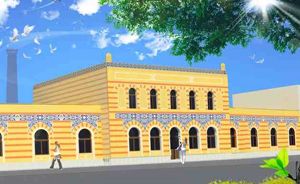 Ishak-beg was appointed by sultan for Krajišnik of Skopje Krajina, which belonged to Bosansko krajište in 1439. Until that, his father, Isa-beg was entitled for that position. Though with several breaks, he remains Krajišnik until 1463. In 1463, sultan Mehmed II Fatih appoints Ishak-beg for the second sanjak-bey (provincial governor) of Bosnia, right after the first one, Mehmed-beg Minetović. In the name of God and sultan's honor, he raised a mosque – commonly known as The Emperor's mosque, in Sarajevo in 1457. Other than that, he also built a castle near the hostel, named The Governor’s castle (Saray), Begluk or Zabeglukom.
Ishak-beg was appointed by sultan for Krajišnik of Skopje Krajina, which belonged to Bosansko krajište in 1439. Until that, his father, Isa-beg was entitled for that position. Though with several breaks, he remains Krajišnik until 1463. In 1463, sultan Mehmed II Fatih appoints Ishak-beg for the second sanjak-bey (provincial governor) of Bosnia, right after the first one, Mehmed-beg Minetović. In the name of God and sultan's honor, he raised a mosque – commonly known as The Emperor's mosque, in Sarajevo in 1457. Other than that, he also built a castle near the hostel, named The Governor’s castle (Saray), Begluk or Zabeglukom.
The name saray ovasi (the plains around the palace) first appears in 1455. That is the name of today's Sarajevo. Among other things, Ishak – beg also built tekke on Bentbaša, Kolobara Han on Baščaršija, a bridge over Miljacka, several mills on Miljacka and number of retails.
Building the inn (caravanserai) together with many shops, he laid the foundation of the economic center, and building the bridge, he connected the oldest settlement around the Emperor's mosque to the new center on the other bank. It is likely that he was buried in harem of the Emperor's mosque. If Ishak-beg was the founder of Sarajevo in the middle of 15th century, then Gazi Husrev-beg actually founded it between twenties and forties’ of 16th century.
Gazi Husrev-beg
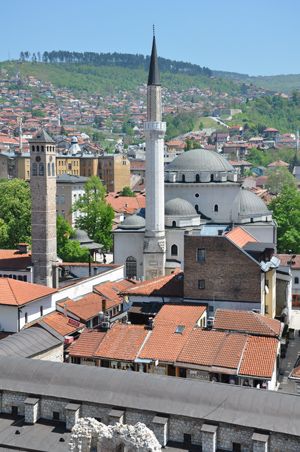 In the time of sultan Suleyman II (1520-1566) there lived the most famous governor and the greatest waqif Bosnia has ever had – Gazi Husrev-beg (1480-1541.) He was born in Rumelia. His father, Ferhat-beg was born in Bosnia and died in 1486 near Adana, as one of the generals of sultan Bayezid II (1481-1512.) fighting against the Egyptian sultan Katibey. His mother Seldžuka, who died very soon - during her father's lifetime - was daughter of sultan Bayezid. In 1521, after the conquest of Belgrade in which he took part, Husrev-beg received an honorary title Gazi.
In the time of sultan Suleyman II (1520-1566) there lived the most famous governor and the greatest waqif Bosnia has ever had – Gazi Husrev-beg (1480-1541.) He was born in Rumelia. His father, Ferhat-beg was born in Bosnia and died in 1486 near Adana, as one of the generals of sultan Bayezid II (1481-1512.) fighting against the Egyptian sultan Katibey. His mother Seldžuka, who died very soon - during her father's lifetime - was daughter of sultan Bayezid. In 1521, after the conquest of Belgrade in which he took part, Husrev-beg received an honorary title Gazi.
Belgrade itself was the key to conquering the rich Hungary and gates of Middle Europe. After the conquest of Belgrade, Gazi Husrev-beg was appointed by sultan for Bosnian sanjak-beg. Under that title, he lived in Sarajevo between 1521 and 1525. That period was filled with wars in neighboring Croatian and Venetian regions. In 1522, he conquered Knin and Skradin and Ostrovica, in 1523. For the following two years (1524-1525) he has been trying to besiege Jajce, though unsuccessfully. Because of his failures, he was temporarily moved from Bosnia. Soon, in January 1526, he was again at the head of Bosnian sanjak, where he remains for eight years, until 1534. During this period, Gazi Husrev-beg took part in the Battle of Mohács in 1526, conquered Obrovac in 1527, Jajce and twelve other towns in 1528. He also took part in the siege of Vienna and Kisek with the army. In 1538 Gazi Husrev-beg occupied Trogir, Nadin and Knin, and Sinj in 1539. During this period, he built his monumental mosque in Sarajevo (1530-1531) and a number of other buildings. Only in Sarajevo in 1532. Gazi Husrev-bey's waqf reached the number of 202 objects.
Gazi Husrev-bey's third governorship in Bosnia started in 1536. During that period, Gazi Husrev-beg was fighting and building charities in Sarajevo as well. In 1537 he built the famous madrasa in Kuršumlija. It was originally named after his mother, Seldžukija, but later it was renamed in Kuršumlija, because of its lead roof. At first, beg's madrasa served as higher Sharia school, visited by qadis for an additional education. Other than subject from the field of Sharia law and higher religious education, this school also taught about rhetoric and other matters demanded by tradition and quart. Later on, madrasa has become religious high school. Previous periods of Bey's madrasa have shown that it was one of the most significant institutions of Bosnian Muslim people. Besides madrasa and mosque, Gazi Husrev-beg also raised a library, a bedestan, an imaret, a maktab, several inns, a guesthouse, a dervish house, a school for women and spa.
It was his benevolence that placed Gazi Husrev – beg, right next to the Ishak – beg Ishaković, among the founders of Sarajevo. Gazi Husrev – beg was killed in 1541. by one highlander. He was buried in mausoleum, next to his mosque, which he built while he was alive. Mausoleum of his first mutawalli Murat – beg Tadić is also located there. He lived in Ćurčića quart, he never married and had no children.
Rustem-paša Opuković
 During the time of Gazi Husrev – beg, the Grand vizier Rustem pasha Opuković was also alive. He was born near Sarajevo. As a child, he was brought to Istanbul, where he rapidly progressed. Sultan Suleyman II thought of him as a prudent, virtuous and cheerful man. He married Sultan's daughter Mihrimah and became favorite of his mother-in-law, Hurem sultan - Roxelana. By 1544. he was already appointed for the Grand vizier. He was brought to that position in 1555. again, and remained until his death, 1561. A huge treasure was left after him. In Istanbul he built Mihrimah mosque, a madrasa, a caravanserai, hammam and a library. The most famous Ottoman architect, Mimar Sinan raised 19 objects for him.
During the time of Gazi Husrev – beg, the Grand vizier Rustem pasha Opuković was also alive. He was born near Sarajevo. As a child, he was brought to Istanbul, where he rapidly progressed. Sultan Suleyman II thought of him as a prudent, virtuous and cheerful man. He married Sultan's daughter Mihrimah and became favorite of his mother-in-law, Hurem sultan - Roxelana. By 1544. he was already appointed for the Grand vizier. He was brought to that position in 1555. again, and remained until his death, 1561. A huge treasure was left after him. In Istanbul he built Mihrimah mosque, a madrasa, a caravanserai, hammam and a library. The most famous Ottoman architect, Mimar Sinan raised 19 objects for him.
In Sarajevo, his hometown he raised Brusa- bezistan, a bridge over Željeznica on Ilidža and next to the bridge, he raised an inn. Rustem pasha's brother, Karađoz – beg has built number of objects in Mostar. Rustem pasha's another brother raised a mosque in Sarajevo, where their sister lived.
Mehmed-paša Sokolović
 Among the most famous Bosnians in Ottoman state, first place undeniably belongs to Mehmed pasha Sokolović. He was the greatest and most significant Grand vizier in Ottoman state during the time of three sultans. Mehmed pasha was born in Sokolovići village, near Rudog. While still a child, he was brought to Edirne, where he was educated. As a young man, he takes part in Battle of Mohács in 1526. and in the siege of Vienna in 1529. after which he became admiral. Mehmed pasha's successful career continued in 1549 when he was appointed for beylerbey of Rumelia.
Among the most famous Bosnians in Ottoman state, first place undeniably belongs to Mehmed pasha Sokolović. He was the greatest and most significant Grand vizier in Ottoman state during the time of three sultans. Mehmed pasha was born in Sokolovići village, near Rudog. While still a child, he was brought to Edirne, where he was educated. As a young man, he takes part in Battle of Mohács in 1526. and in the siege of Vienna in 1529. after which he became admiral. Mehmed pasha's successful career continued in 1549 when he was appointed for beylerbey of Rumelia.
In the war against the Habsburg monarchy, Mehmed pasha was the commander in chief of the entire Ottoman army. In 1555, for his military merits, he was appointed for the third vizier. A year later, he became sultan Selim II's son-in-law. In 1565, as a sixty-year-old man, he reached his biggest success, by becoming a Grand vizier of the Ottoman state, where he remains for 14 years. In 1566, together with sultan Suleyman II, he besieged the fortress of Siget in southwestern Hungary which was defended by Nikola Zrinjski.
During that battle, the sultan died and Sokolović decided to cover up his death so that it does not affect his army. It was only when sultan Selim II came to the power that Sokolović informed army about Suleyman's death. He was the actual leader of the Ottoman state in time of Selim II and Murat III. As a Grand Vizier, he compelled the Hapsburg’s' Monarchy to peace and in 1571 he occupied Yemen. Sokolović also rebuilt the Ottoman fleet, which was defeated and weakened at Lepent in 1571. Mehmed pasha worked on development of education, art and literature as well.
He even planned to dig the Don-Volga canal to connect the Black Sea with the Caspian Sea. He also planned to dig the Suez Canal. Thanks to his help and understanding, the Patriarchate of Peć led by his cousin Macarius, was restored in 1577.
In his hometown, he built a mosque. The greatest architectural work is his bridge in Višegrad, built in 1571. 180 meters long with 11 bends. After he died, the power of Ottoman empire started to decline.
Ferhad-beg Sokolović
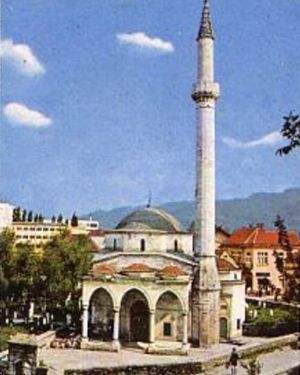 He was the famous Mehmed pasha Sokolović's nephew. Before he became Bosnian sanjak-beg, he had been performing duties of sanjak beg of Klis. In the war against Venetians, in 1566, he occupied Zemunik, Brodin, Bijela Stijena and in 1570 the fortress of Vespoljac, which he named Seddi Islam- the wall of Islam.
He was the famous Mehmed pasha Sokolović's nephew. Before he became Bosnian sanjak-beg, he had been performing duties of sanjak beg of Klis. In the war against Venetians, in 1566, he occupied Zemunik, Brodin, Bijela Stijena and in 1570 the fortress of Vespoljac, which he named Seddi Islam- the wall of Islam.
Ferhat – beg demonstrates his ability as military leader and warrior in the Cyprus wars (1571.-1574.) At that time, he invades Šibenik and Zadar with his army. After he conquered Zemunik, Pločnik, Skradin, Drniš, Obrovac, Pule, Vičev, Ferhat – beg significantly expanded the territory of Sanjak of Klis. To prevent large attack on Bosnia by Croatian army, Ferhat – beg defeated the Zagreb canon Franjo Filipović and sent him to Istanbul where the canon converted to Islam and named himself Mehmet. For his great war merits, he was appointed for Bosnian sanjak-bey in 1574. Ever since his warfare in Slovenia and Croatia has started. For the first time, as Sanjak bey of Bosnia, he led a military campaign of 12.000 of soldiers towards Bihać.
By 1575 he has already achieved a great victory at Budački. In the name of Count Auerspeg's captured son, he received 30 000 ducats. He used that money to build a mosque which he named after himself, Ferhadija. In 1576, he occupied Bužim and Cazin, and in 1577 Mutnik, Velika Kladuša, Šturlić, Pećigrad, Podzvizda. In this way he took all the places around the Una except for Bihać. In 1580, when Bosnian eyalet was founded, Ferhat-beg who received the title of pasha, was appointed for its first beylerbey. He remained in that position for 8 years. In 1588 he was appointed for beylerbey of Buda where he spent two years, and in 1590 he was murdered.
He was buried in his mausoleum, next to the Ferhadija mosque. In the town on Vrbas, Ferhat-beg has raised 216 of public objects, the most important of which is the mosque. Around the mosque, he had 200 shops, a caravanserai, a hammam, a palace-yard and some other facilities built.
We can rightfully say that what Gazi Husrev-beg was for Sarajevo, Ferhat-beg was the same for Banja Luka. Just like Mehmed pasha Sokolović, Ferhat-beg was also very steady, calm and composed, carefully raised according to Islam.
Hadži Mehmed-beg Karađoz
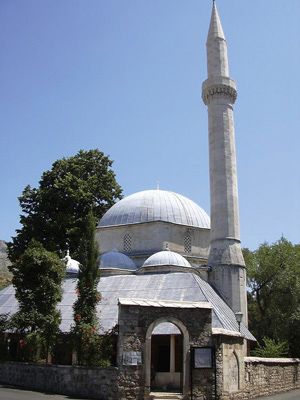 Hadži Mehmed-Karađoz was the greatest legator of Mostar and the entire Herzegovina. He was born in Potoci, in Bijelo polje, 12 kilometers north from Mostar. He was known as Karađoz-beg, a nickname he received for his clarity (karađoz-the black-eyed) From his endowment charter it is evident that he had three sons: Muhamad, Yusuf and Suleyman; from the inscription on mosque it is evident that he was brother of the Grand vizier, Rustem pasha Opuković.
Hadži Mehmed-Karađoz was the greatest legator of Mostar and the entire Herzegovina. He was born in Potoci, in Bijelo polje, 12 kilometers north from Mostar. He was known as Karađoz-beg, a nickname he received for his clarity (karađoz-the black-eyed) From his endowment charter it is evident that he had three sons: Muhamad, Yusuf and Suleyman; from the inscription on mosque it is evident that he was brother of the Grand vizier, Rustem pasha Opuković.
Karađoz died in Mostar around 1564, and he was probably buried in graveyard of his mosque. Karađoz-beg built a mosque under the dome in Mostar, together with a maktab, a madrasa, a library, an imaret and a guesthouse. Beside all these endowments, he raised a masjid in Potoci, two maktabs in Konjic and Potoci, four bridges: in Konjic, on Buna and two in Lištica and an inn in Mostar, Konjic, Čičevo and Potoci. From the funds of this endowment, a hammam was built later in Blagaj, a small stone bridge near the mosque in Potoci and a fountain next to mosque in Mostar.
To maintain these institutions, he endowed 42 trade shops in the Mostar čaršija, 16 workshops near the imaret where tanners worked, 6 mills and 2 cloth rolling pillars in the village of Knešpolje in the Blato nahiyah, eight mills and two pillars at the spring of the Buna, some of land in Mostar and Knešpolje and 300,000 Ottoman dirhams in cash. In 1889. this waqf owned 271 shops, 10 warehouses, 1 bakery and five cemeteries.
What Gazi Husrev beg was to Sarajevo, Ferhat beg was to Banja Luka and Karađoz – beg for Mostar
Ali-paša Rizvanbegović
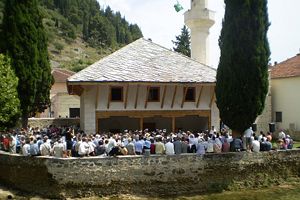 Ali-pasha Rizvanbegović was the greatest waqif of Stolac. In 1836, he endowed as follows: all stupas in Stolac - number and locations of which is familiar to the neighbors, a bakery and five shops in the big bazaar, longue at garden - known as „mešćema“ cafe with a floor which is located next to the barber shop of Salih-beg Jašarbegović, three shops and a warehouse in the Podgrad quarter, several mills and vineyards in Stolac and its surroundings. As well as 3,000 groschen.
Ali-pasha Rizvanbegović was the greatest waqif of Stolac. In 1836, he endowed as follows: all stupas in Stolac - number and locations of which is familiar to the neighbors, a bakery and five shops in the big bazaar, longue at garden - known as „mešćema“ cafe with a floor which is located next to the barber shop of Salih-beg Jašarbegović, three shops and a warehouse in the Podgrad quarter, several mills and vineyards in Stolac and its surroundings. As well as 3,000 groschen.
This waqf was founded in 1889. and in his possession had the following: 11 shops, 6 houses, 4 mills, a pillar, a tavern, 15 vineyards, 2 fields, 2 olive groves and 2 construction sites. He determined that his endowments in Stolac will be supported from the income of the mentioned real estate.